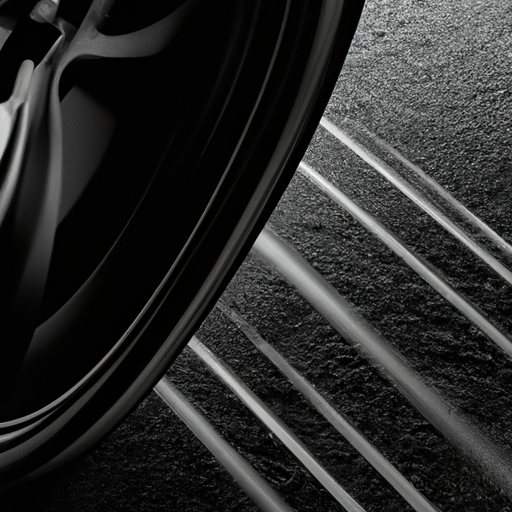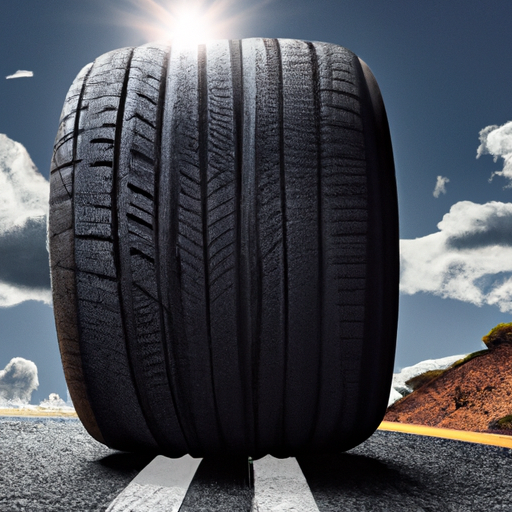Imagine a sunny, clear summer day. You’re cruising down the road, enjoying the warm breeze as you tackle each curve with precision. But have you ever wondered how the type of tires on your car can impact your braking distances on these dry roads? In this article, we’ll explore just that. We’ll uncover the secrets behind how summer tires, specifically designed for warm weather conditions, affect braking distances on dry roads. So buckle up and get ready to uncover the science behind your summer driving experience.
Factors Affecting Braking Distances
Road Condition
The condition of the road surface plays a significant role in determining braking distances. Smooth and well-maintained roads generally provide better traction, allowing the tires to grip the surface more effectively and reduce braking distances. On the other hand, roads with loose gravel, potholes, or uneven surfaces can decrease the tire’s grip, leading to longer braking distances.
Tire Type
The type of tire used can have a considerable impact on braking distances. Summer tires, also known as performance tires, are specifically designed for warm weather conditions. Their unique composition and tread pattern allow them to provide optimal grip and traction on dry roads, resulting in shorter braking distances compared to other tire types.
Tread Pattern
The tread pattern of a tire refers to the design of the grooves and channels on its surface. Summer tires are engineered with a tread pattern that prioritizes dry road performance, typically featuring larger, continuous tread blocks. This design maximizes the tire’s contact patch with the road, increasing traction and improving braking performance.
Tire Compound
The composition of the tire compound is another critical factor affecting braking distances. Summer tires are made with a rubber compound that is specifically formulated to maintain flexibility and grip at higher temperatures. This feature allows the tires to have excellent traction on dry roads, resulting in shorter braking distances.
Tire Pressure
Proper tire pressure is essential for optimal braking performance. Underinflated tires can negatively impact braking distances, as they create a larger contact patch and increase rolling resistance. On the other hand, overinflated tires may reduce the contact patch and compromise grip. It is crucial to regularly check and maintain the recommended tire pressure to ensure safe and efficient braking.
Understanding Summer Tires
Definition
Summer tires, as the name suggests, are designed for use in warmer weather conditions. These tires are specifically engineered to provide superior performance and grip on dry roads, making them ideal for driving during the summer months. They are often characterized by their unique tread patterns, rubber compounds, and advanced construction techniques.
Composition
The composition of summer tires is optimized to deliver exceptional performance on dry roads. The rubber compound used in their construction is softer and stickier than that of all-season tires, allowing for enhanced grip and traction. Additionally, summer tires often feature high-performance materials and technologies that contribute to their overall performance and handling capabilities.
Advantages
One of the primary advantages of summer tires is their superior grip on dry roads. The softer rubber compound and specialized tread pattern enable these tires to maintain excellent traction, allowing for shorter braking distances and improved handling. Summer tires also tend to have enhanced cornering capabilities, providing drivers with increased control and responsiveness.
Limitations
While summer tires excel in warm weather conditions, they do have some limitations. The softer rubber compound that provides optimal traction on dry roads tends to harden in colder temperatures, reducing their performance and grip. Additionally, summer tires may not perform as well in wet or snowy conditions, as their tread design is not optimized for dispersing water or gaining traction on slippery surfaces.

Braking Mechanism with Summer Tires
Tire Grip on Dry Roads
Summer tires exhibit exceptional grip on dry roads due to their specialized tread pattern and rubber compound. The continuous, larger tread blocks of summer tires provide a larger contact patch with the road, maximizing traction. This allows the tires to effectively grip the road surface during braking maneuvers, resulting in shorter braking distances.
Braking Force and Friction
During a braking event, the force applied by the driver’s foot is transferred to the tires, generating friction between the tire and the road surface. The frictional forces between the summer tires and the dry road aid in deceleration and stopping the vehicle. Summer tires, with their superior grip and traction, can generate higher frictional forces, leading to improved braking performance and reduced braking distances.
Reduced Braking Distances
The combination of superior grip, traction, and braking force generated with summer tires results in reduced braking distances on dry roads. The optimized tread pattern and rubber compound work together to ensure maximum contact between the tire and the road, allowing for efficient transfer of braking force. This characteristic of summer tires provides drivers with increased confidence and a shorter stopping distance in emergencies.
Comparison with All-Season Tires
Tread Compound and Design
In comparison to summer tires, all-season tires are engineered to provide acceptable performance in a wide range of weather conditions. The tread compound of all-season tires is designed to be durable and to provide adequate grip on both dry and wet surfaces. However, this compromise in compound composition means that all-season tires are generally less capable of delivering the level of grip and performance that summer tires offer on dry roads.
Braking Performance on Dry Roads
When it comes to braking performance on dry roads, summer tires outperform all-season tires. The unique design and composition of summer tires allow them to grip the road more effectively, resulting in shorter braking distances. All-season tires, while suitable for various weather conditions, do not possess the same level of traction as summer tires specifically engineered for dry road performance.

Testing Braking Distances
Standardized Braking Tests
Braking distances are typically measured through standardized braking tests. These tests involve bringing a vehicle to a complete stop from a specific speed while measuring the distance it takes to do so. Testing organizations employ controlled environments and consistent methodologies to ensure accurate and comparable results. These tests allow manufacturers and consumers to evaluate the braking performance of different tires and vehicles.
Impact of Speed on Braking Distance
The speed at which a vehicle is traveling directly affects its braking distance. As the speed increases, the braking distance also increases. This relationship is due to several factors, including the increased energy and momentum of the moving vehicle and the time it takes for the driver to perceive and react to the need for braking. It is crucial to maintain safe and legal speeds to minimize braking distances and ensure the safety of both the driver and other road users.
Effects of Tire Maintenance
Tire Inflation
Proper tire inflation is crucial for optimal braking performance. Underinflated tires create a larger contact patch, increasing rolling resistance and resulting in longer braking distances. Overinflated tires, on the other hand, reduce the contact patch and compromise grip. It is important to regularly check and maintain the recommended tire pressure to ensure safe and efficient braking.
Tire Rotation
Regular tire rotation is recommended to promote even tire wear and maintain consistent braking performance. Uneven wear can lead to imbalanced traction, affecting braking distances and overall handling. By rotating the tires at the recommended intervals, the wear patterns are equalized, ensuring uniform traction and maximizing braking performance.
Wheel Alignment
Proper wheel alignment is essential for optimal braking performance and tire wear. Misaligned wheels can cause uneven tire wear and compromised grip, negatively affecting braking distances. Regular wheel alignment checks and adjustments help ensure that the tires maintain optimal contact with the road surface, allowing for efficient transfer of braking force.

Driving Techniques to Reduce Braking Distances
Anticipating and Planning
One effective way to reduce braking distances is through anticipation and planning. By observing the road ahead and recognizing potential hazards or obstacles, drivers can adjust their speed and maintain a safe following distance. Anticipating potential braking situations allows for smoother and more gradual braking, reducing the need for sudden and harsh stops.
Maintaining Safe Distance
Maintaining a safe distance from the vehicle in front is crucial for reducing braking distances. The recommended following distance is typically three to four seconds, allowing for adequate time to perceive and react to changes in traffic conditions. By keeping a safe distance, drivers have more time to brake gradually, resulting in shorter braking distances and a decreased likelihood of rear-end collisions.
Smooth Braking Application
Applying brakes smoothly and progressively can significantly reduce braking distances. Sudden, harsh braking can lead to wheel lock-up and loss of control, ultimately increasing the distance required to stop the vehicle. By gradually engaging the brakes and allowing them to respond to the driver’s input, the tires maintain better traction and optimize braking performance.
Considerations for High-Performance Vehicles
Importance of Summer Tires
For high-performance vehicles, the importance of summer tires cannot be overstated. These vehicles require tires that can handle the increased power and performance capabilities, especially during acceleration and braking. Summer tires provide the necessary grip and traction on dry roads, allowing high-performance vehicles to fully utilize their potential while maintaining control and safety.
Matching Tire Capabilities with Vehicle Performance
It is essential to match the tire capabilities with the performance characteristics of high-performance vehicles. Investing in high-quality summer tires that are specifically designed for these vehicles ensures optimal braking performance and overall handling. Choosing the right tire size, load rating, and speed rating is crucial to maintain the balance between performance, safety, and comfort.

Potential Downsides of Summer Tires
Limited Traction in Cold Conditions
One potential downside of summer tires is their limited traction in cold weather conditions. The softer rubber compound that provides optimal grip on dry roads tends to harden in colder temperatures, compromising traction and braking performance. In situations where temperatures drop below freezing or in snowy and icy conditions, it is advisable to switch to winter tires for optimal safety and performance.
Reduced Performance on Wet Surfaces
While summer tires excel on dry roads, their performance on wet surfaces can be reduced. The tread pattern of summer tires is designed to maximize grip on dry pavement, often sacrificing water dispersion capabilities. This can result in reduced traction and increased braking distances on wet roads. Drivers should exercise caution and adjust their driving techniques when encountering wet conditions while using summer tires.
Conclusion
Braking distances are influenced by various factors, including road conditions, tire type, tread pattern, tire compound, and tire pressure. Summer tires, with their superior grip on dry roads, offer significant advantages in terms of braking performance and reduced braking distances. These tires are specifically designed to provide optimal traction and handling during the warmer months. While they may have limitations in cold and wet conditions, their benefits on dry roads make them a valuable choice for drivers seeking improved safety and performance. It is important to consider factors such as tire maintenance, driving techniques, and vehicle compatibility to maximize the benefits of summer tires while ensuring road safety.


